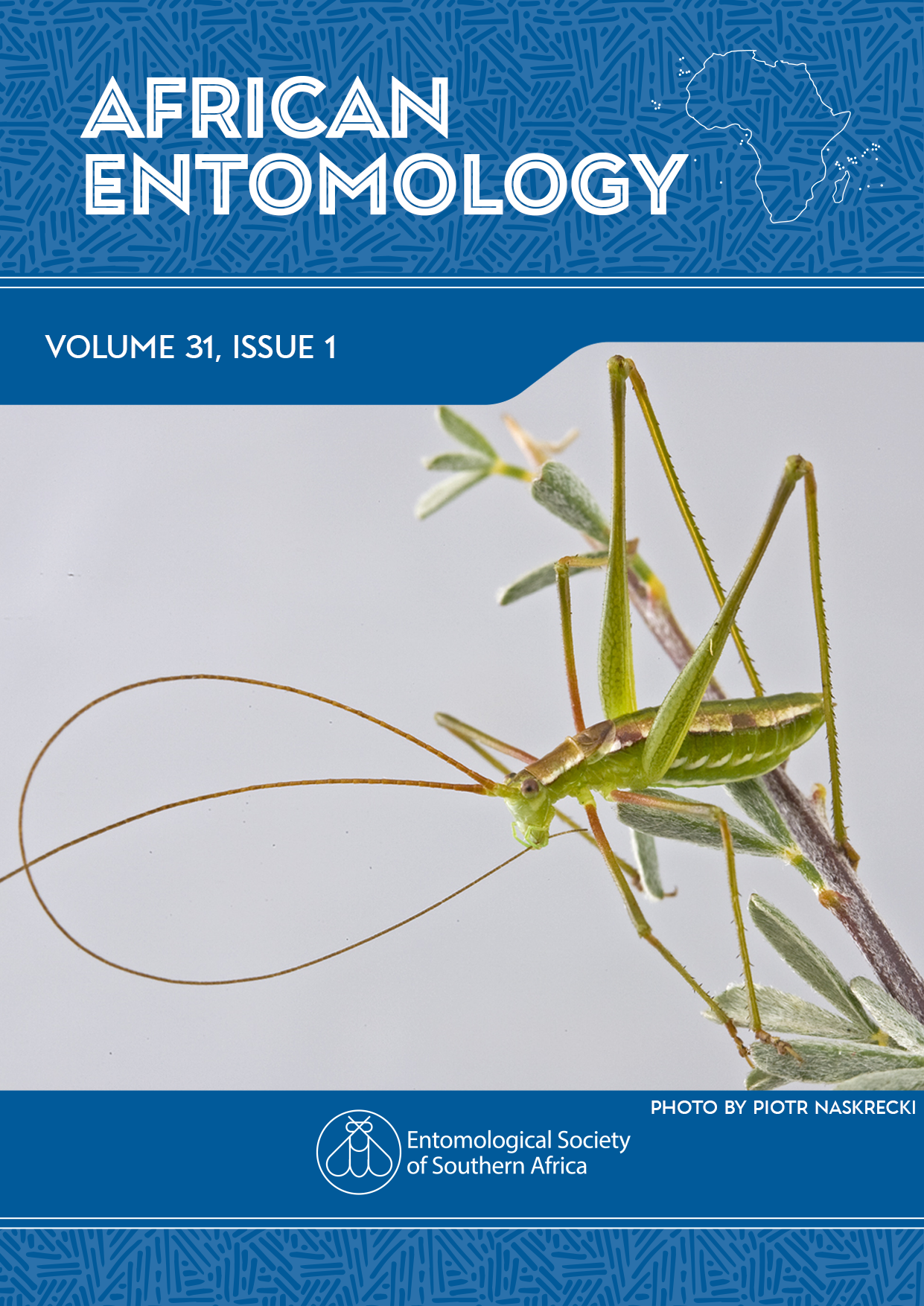First records of Brephidium exilis (Boisduval) (Lepidoptera: Lycaenidae) from south-western part of the Arabian Peninsula suggests possible further dispersal into North Africa
DOI:
https://doi.org/10.17159/2254-8854/2023/a15990Keywords:
alien species, range expansion, ruderal habitat, long distance dispersalAbstract
During surveys in February and September 2022 focused on the butterfly fauna of the mountainous southwestern part of the Kingdom of Saudi Arabia, we unexpectedly discovered the alien species Western Pygmy Blue (Brephidium exilis) at two locations. These are the first records of this species in the southwestern part of the Arabian Peninsula, where its main range was previously restricted to the Arabian Gulf region. Adults were observed at atypical elevations and in forested areas. These findings indicate greater ecological plasticity of the species and possibly suggest its further dispersal into North Africa and the Mediterranean region. While long distance dispersal from Arabian gulf region seems the most reasonable origin, human introduction via transfer of host plants could not be excluded.
Downloads
References
de Vries H, Lemmens M. 2022. Observation.org, Nature data from around the World. Observation.org. Occurrence dataset https://doi.org/10.15468/5nilie accessed via GBIF.org on 2023-01-18. https://www.gbif.org/occurrence/3826158383
Graves SD, Shapiro AM. 2003. Exotics as host plants of the California butterfly fauna. Biological Conservation. 110(3):413–433. https://doi.org/10.1016/S0006-3207(02)00233-1
iNaturalist contributors, iNaturalist. 2023a. iNaturalist Research-grade Observations. iNaturalist.org. Occurrence dataset https://doi.org/10.15468/ab3s5x accessed via GBIF.org on 2023-01-18. https://www.gbif.org/occurrence/3986198166
iNaturalist contributors, iNaturalist 2023b. iNaturalist Research-grade Observations. iNaturalist.org. Occurrence dataset https://doi.org/10.15468/ab3s5x accessed via GBIF.org on 2023-08-09. https://www.gbif.org/occurrence/4137745586
Jamieson D, Denny J. 2001. Hawaii's butterflies and moths: an identification guide to easily observed species. A Hawaii Biological Survey Handbook. Honolulu: Mutual Publishing.
Feulner GR. 2003. Two new butterfly sightings from the Musandam region. Tribulus 12(1):30.
Gillet MPT. 1999. Preliminary notes on some newly recorded butterflies from the UAE and adjacent parts of northern Oman (Lepidoptera: Rhopalocera). Tribulus 9(1):22–23.
Gillet MPT. 2002 Occurrence of the Western Pygmy Blue butterfly Brephidium exilis [Boisduval] on offshore islands of Abu Dhabi, including Marawah Island (Lepidoptera: Lycaenidae). Tribulus 12(2):20–21.
Larsen TB. 1982. The importance of migration to the butterfly fauna of Arabia (Lepidoptera; Rhopalocera). Atalanta 13:248–259.
Larsen TB. 2000. Hazards of butterfly collecting – late 1999. What is Brephidium exilis doing in the Emirates? Entomologist's Record and Journal of Variation 112(6):273–274.
Otto HHH. 2014. A new locality and larval host plant recorded for Brephidium exilis exilis (Boisduval, 1852) on the Arabian Peninsula. Metamorphosis 25:97–99.
Pittaway AR. 1986. Lepidoptera: Rhopalocera of Western Saudi Arabia. Fauna of Saudi Arabia 7:172–197.
Pittaway AR, Larsen TB, Legrain A, Majer J, Weidenhoffer Z, Gillet M. 2006. The establishment of an American butterfly in the Arabian Gulf: Brephidium exilis (Boisduval, 1852) (Lycaenidae). Nota Lepidopterologica 29(1/2):3–14.
Pope M, Nithyanandan M. 2014. Record of the Western Pygmy Blue butterfly Brephidium exilis (Boisduval, 1852) (Lepidoptera: Lycaenidae) from Sabah Al Ahmad Sea City, Kuwait. Journal of Threatened Taxa. 6(14):6723–6725. http://dx.doi.org/10.11609/JoTT.o4055.6723-5
Pyle RM. 1981. National Audubon Society Field Guide to North American Butterflies. New York: Alfred A. Knopf, Inc.
Shapiro AM. 1973. Host records for Brephidium exilis (Lycaenidae). Journal of the Lepidopterists' Society 27(2):157–158.
Scott JA. 1986. The Butterflies of North America. Stanford University Press, California, U.S.A.
Surkes S. 2021. Out of the blue: Butterfly experts aflutter over arrival of foreign species at Dead Sea. The Times of Israel. 11 August 2021. https://www.timesofisrael.com/butterfly-experts-aflutter-over-arrival-of-foreign-species-at-dead-sea (Accessed 18 January 2023).
Tshikolovets V. 2022. Notes on butterflies of Saudi Arabia with a description of a new subspecies (Rhopalocera, Lycaenidae, Nymphalidae et Hesperiidae). Atalanta 53 (1/2):205–208.
Vis R. 2010. Recent geographic range expansion of Brephidium exilis (Boisduval, 1852) (Lycaenidae) in Oman, Arabian Peninsula. Nota Lepidopterologica 33(1):133–134.
Downloads
Additional Files
Published
Issue
Section
License
Copyright (c) 2023 Rudi Verovnik, Marko Kosmač, Alrabea Ishag, Hathal Al Dhafer

This work is licensed under a Creative Commons Attribution 4.0 International License.




.png)